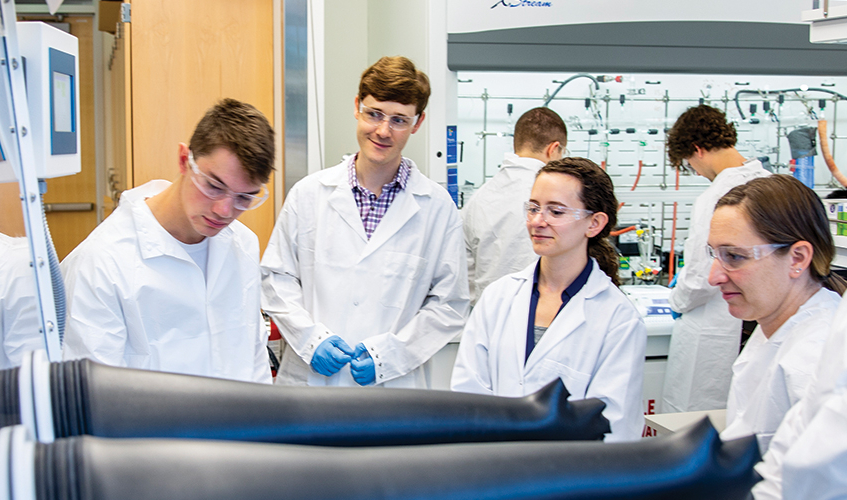By Lindsey Doermann
January 10, 2019


If one were to poll students on their favorite classes, quantum mechanics might not rise to the top of the list. Unless perhaps they took Vincent Holmberg’s Quantum Mechanics for Chemical Engineers course. Holmberg, a ChemE assistant professor who studies inorganic nanomaterials, developed the class during his first year in Seattle and received a 5.1 out of 5.0 teaching rating for it in fall 2016. In addition, his newly-developed graduate-level Nanomaterials Chemistry and Engineering course was recognized by the Dean’s Office as one of the most highly rated courses in the entire College of Engineering in spring 2016. And those represent just half of the courses he has been involved with since his arrival.
Holmberg joined the ChemE faculty in 2015 and wasted no time in setting up ambitious research, teaching and outreach activities. With research, he’s engineering the properties of functional nanomaterials that have the potential to be manufactured in a scalable, cost-effective manner. When it comes to batteries, his lab is working to better understand and control the phase transformations, interfacial reactions, and other fundamental processes that occur when you charge and discharge a battery. They are studying the effects of chemical additives, controlled surface chemistry, and engineered electrode morphology in an effort to improve energy storage capacity, charge/discharge rates, and battery longevity.
Holmberg is also engineering functional luminescent and plasmonic nanostructures that can be used to manipulate light for energy harvesting, medical diagnostics and display technologies. He and his colleagues are also excited about upcoming work that “flips the script" and uses light to control, manipulate and produce novel nanomaterials.
 Back on the educational front, Holmberg and his graduate student Elena Pandres worked with the Clean Energy Institute (CEI) and students and faculty from five departments in the summer of 2017 to help construct a portion of CEI's Research Training Testbed facility in the Nanoengineering & Sciences Building. The space (above) serves as a state-of-the-art clean-energy research facility, where he and his colleagues can also run CEI's new Energy Materials, Devices, and Systems lab course. In the class, students get hands-on experience with clean tech from the molecular scale all the way up to the grid level, doing everything from fabricating thin-film solar cells to building electrical grid simulations. After all the hard work, Pandres showcased the new lab space with a battery technology demonstration for Governor Jay Inslee and Provost Mark Richards in August 2018 (right).
Back on the educational front, Holmberg and his graduate student Elena Pandres worked with the Clean Energy Institute (CEI) and students and faculty from five departments in the summer of 2017 to help construct a portion of CEI's Research Training Testbed facility in the Nanoengineering & Sciences Building. The space (above) serves as a state-of-the-art clean-energy research facility, where he and his colleagues can also run CEI's new Energy Materials, Devices, and Systems lab course. In the class, students get hands-on experience with clean tech from the molecular scale all the way up to the grid level, doing everything from fabricating thin-film solar cells to building electrical grid simulations. After all the hard work, Pandres showcased the new lab space with a battery technology demonstration for Governor Jay Inslee and Provost Mark Richards in August 2018 (right).
Holmberg’s propensity for inspiring others to think on the nanoscopic scale goes well beyond the classroom. His group is highly committed to STEM outreach, and in an effort spearheaded by graduate student Brittany Bishop, his lab members participated in more than 25 outreach events in the past year. They created demonstrations of quantum dots, wind power, and electromagnetism, and ran them in K-12 schools, at maker faires, and in STEM expos in the greater Seattle area.
To put it simply, Holmberg not only wants to do his own cool science, but he also wants to support others’ creative research efforts. He serves as the official Hertz Foundation University Representative for UW and runs regular fellowship information sessions for interested students. He also recently helped the Washington Research Foundation launch its WRF Postdoctoral Fellowship program in an effort to attract new research talent to the state.
He finds UW and the ChemE department an ideal place to accomplish his goals. “I have fantastic colleagues across the department and campus,” he says, “and the department is focused on giving students a great education.” Quantum mechanics and materials chemistry included.